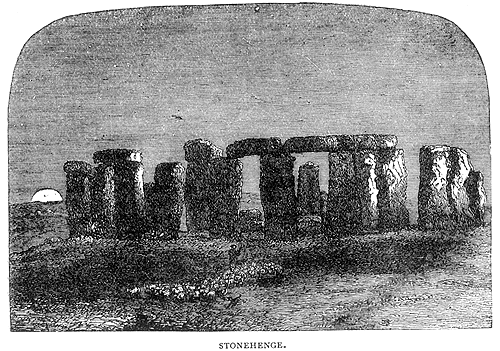 |

T was a lovely summer day when we first saw Stonehenge. The great Wiltshire plain lay calm and silent before us as we descended from the carriage that brought us from Salisbury. Over the rich green grass the shadows of a few clouds were slowly flitting before the soft breeze; but the silence, as we walked towards the ancient temple, was 60 profound as to be remarkable. It was with feelings of awe that we gazed on that strange, wonderful monument of the past; dating, antiquarians tell us, from before, or nearly at, the period of the Roman invasion. The stern magnificence of this magic circle of huge stones struck us with wonder and awe.
In 1869, Mr. Hall wrote to the Athenoeum on the subject of Stonehenge, and gave the following reason for believing that Stonehenge is a work of post-Roman times. "It is clearly understood," he says, "that the Romans introduced the art of working in stone - an art lost to us by the withdrawal of their legions, and the consequent invasion of the Saxon barbarians, but restored by Norman influence under the later Saxon kings." But there are great differences of opinion about the period when those mighty stones were placed on Salisbury Plain.
The stones formed originally two large circles; they are raised on their ends, and across the top of them are laid other stones. The outer circle probably contained thirty eight stones, of which seventeen are standing; of the large trilithons only two are now complete. There is a local superstition that no two people ever count the number of the stones alike. When we visited it, we tried counting, and grew confused over it. Within the circle, at that time, at one end of it was a huge stone with a narrow channel in it, apparently meant to carry off the blood of the sacrifices; for that it was a Druidical temple is generally allowed.
 "The temples in which the Britons worshipped their deities," says Sir Francis Palgrave, "were composed of large rough stones disposed in circles; for they had not sufficient skill to execute any finished edifices. Some of these circles are still existing, such as Stonehenge, near Salisbury; the huge masses of rock may still he seen there, grey with age; and the structure is still sufficiently perfect to enable us to understand how the whole pile was anciently arranged. Stonehenge possesses a stern and savage magnificence. The masses of which it is composed are so large that the structure seems to have been raised by more than mortal power. Hence Choirganer (the Giants' Dance, the British name for Stonehenge) was fabled to have been built by giants, or otherwise constructed by magic art; and the tradition that Merlin the enchanter brought the stones from Ireland is felt to be a poetical homage to the greatness of the work. All around you in the plain you will see mounds of earth, or tumuli, beneath which the Britons buried their dead. Antiquaries have sometimes opened these mounds, and then they have discovered vases, containing the ashes and the bones of the primeval Britons, together with their swords and hatchets, and arrow heads of flint or of bronze, and beads of glass and amber."
It is a terrible vision that transports us to Stonehenge when it was really a place of worship, when the Druids in their white robes, oak crowned and wearing the mythic serpent's egg round their neck, came to offer human sacrifices to Bel (the sun) and to the serpent; while, if it were Midsummer, the Beltane fires glowed all over the great plain. And the unhappy victims - can we not imagine their shrinking horror ? Of these human sacrifices there is no doubt. "They held it right," Tacitus says, "to stain their altars with the blood of prisoners taken in war, and to seek to know the mind of the gods from the fibres of human victims."
From these terrible imaginations we were roused by a sound without the temple; it was the peaceful song of a shepherd and the rush of the flock he led, and with a sigh of relief we issued from the unhallowed circle, where human blood had flowed..
|
 |